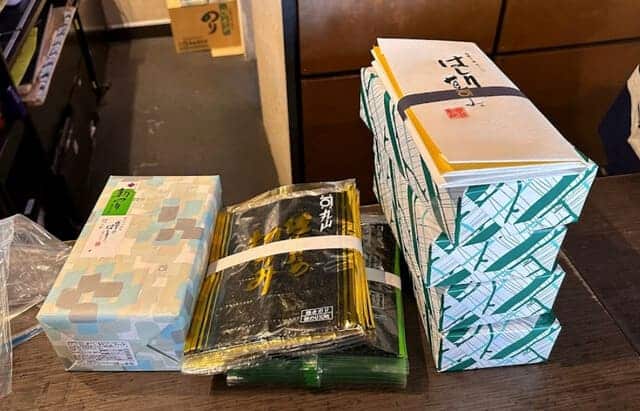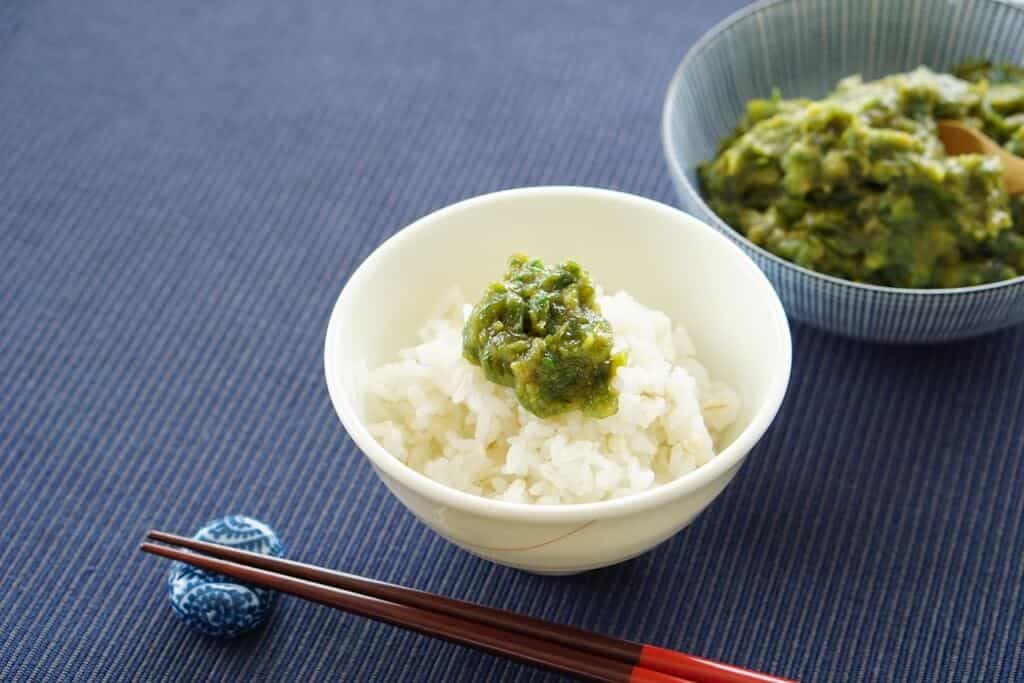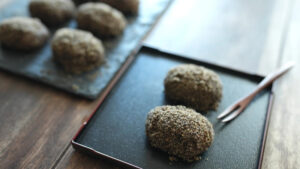Discover the culinary delight of Nori in Japan! This edible seaweed toasted perfectly, adds a unique savory crunch to beloved dishes like sushi and rice balls. Dive into the rich history of nori, explore its cultural significance, and learn about its nutritional benefits. From its origins to its versatile applications in Japanese cuisine, this article offers a brief yet insightful journey into the world of nori, inviting you to savor the essence of this beloved ingredient.
What is Toasted Seaweed?

Nori is an edible algae that includes red, green, and blue-green algae, also known as cyanobacteria. Nori is an edible seaweed that comes in thin, paper-like sheets. These sheets are typically made by shredding and then pressing the seaweed into a flat form. The seaweed is harvested, washed, and then toasted or dried to create the final product. Nori has a unique savory flavor and a crispy texture when toasted. It is commonly used in Japanese dishes, such as sushi, rice balls (onigiri), and seaweed rolls (maki). Nori is also sometimes used as a garnish for soups and noodles.
In Japan, it was historically referred to as “Shina” and “Shinsenna.” People eat raw seaweed and processed algae, which are turned into plate seaweed. It is commonly used in Japanese cuisine as a side dish for rice, for wrapping rice balls and sushi rolls, and as an ingredient in noodles like zaru soba. The term “nori” comes from “nura,” meaning slimy. Initially called “sweet seaweed,” at the end of the Heian period, Asakusa nori, a type of seaweed sheet, gained popularity from the Edo period onwards. Seaweed is highly nutritious, containing protein, dietary fiber, vitamins, calcium, EPA, taurine, beta-carotene, and amino acids. Besides Japan, seaweed is cultivated in China, South Korea, the United Kingdom, and New Zealand. While there was an attempt at seaweed aquaculture in the United States in the 1980s, it was unsuccessful.
Toasted Seaweed History

During the Kamakura period, a significant shift occurred in Japanese food culture. The extravagant eating habits of court nobles and aristocrats led to the development of frugal and perfected vegetarian cuisine. Nori, valued in Buddhist culinary traditions incorporating traditional Japanese ingredients, played a crucial role in this transformation. The roots of today’s nori industry can be trace back to the Edo period. Asakusa nori, nori rolls, and the initiation of nori farming marked this era. Seaweed cultivation started in Tokyo Bay, particularly in Shinagawa and Omori, to provide fresh seaweed to the shogunate. The seaweed presented became a valuable source of revenue for the shogunate, leading to its sale in the market. Aquaculture significantly increased seaweed availability, turning it into an Edo specialty embraced by the common people.
In the middle of the Edo period, square sheets of seaweed crafted with bamboo screens emerged. Seaweed rolls, where rice wrapped around various toppings, gained popularity among the common people, akin to today’s fast food. While seaweed farming began during this period, the lack of understanding of seaweed’s life cycle led to unpredictable production. Referred to as “Unso” in the market, seaweed faced instability until Ms Drew of England discovered the filamentous bodies of seaweed in 1949. This discovery elucidated the previously unknown life cycle of seaweed. It paved the way for the practical application of artificial seedling collection, reducing uncertainties in production. Despite starting from scratch after the war, seaweed farming has thrived, with technological innovations leading to a stable production system of approximately 7 billion sheets annually.
Nori Day

Did you know that there is a “Nori Day”? February 6 is that day. In 1966 (Showa 41), the National Seaweed and Shellfish Fisheries Cooperative Federation established “Seaweed Day” as a collective gesture of seaweed fishermen nationwide, expressing gratitude for seaweed as a gift from the sea. It was set as February 6, and commemorative events have been held yearly. Based on this historical fact, the Zen-Nori Fisheries Association holds a festival every year to pray for the development of the industry, as January 1, 2017, when the Taiho Ritsuryo Code came into effect, is converted to February 6, 702, according to the Western calendar.
Health Information of Nori

Nori, the roasted seaweed, offers numerous health benefits to well-being. Packed with vitamin C, just three sheets of nori provide the same amount of this essential nutrient as one tangerine. Vitamin C is a potent whitening agent, suppressing melanin production, preventing age spots, and even fading existing ones. Notably, the vitamin C in seaweed is heat-resistant, retaining its nutritional value even when cooked.
Dietary fiber, constituting about one-third of seaweed, promotes digestive health and provides a sense of refreshment. This fiber is particularly effective against constipation, lowers blood cholesterol, and helps eliminate carcinogens, offering preventive benefits against adult diseases like arteriosclerosis, diabetes, and colon cancer. Additionally, seaweed contains 12 types of vitamins, with just three sheets providing the daily vitamin A requirement for a growing child, making it an appealing alternative for those who may not fancy green and yellow vegetables.
Furthermore, seaweed prevents anemia, as five pieces contain as much iron as one slice of beef liver or one cup of boiled spinach. The rich mineral content in seaweed, including calcium and iodine, addresses common deficiencies in modern diets. Two sheets of nori contain as much calcium as approximately 15 cc of milk or half an egg, promoting strong bones and offering relief from irritation. Particularly beneficial for growing children and pregnant women, incorporating seaweed into one’s diet can contribute significantly to maintaining good health.
Types of Toasted Seaweed

Seaweeds are divided into three types. As the name suggests, seaweeds live in seawater, and those that live in freshwater, such as rivers, are called freshwater algae.
Green algae
Ulva, Aonori, Kasanori, etc. Of the three types, this seaweed lives in the shallowest waters. It contains a lot of chloroplasts, which have the pigment chlorophyll necessary for photosynthesis. Its bright green appearance characterizes it.
Brown algae (Kassorui)
Kelp, wakame, hijiki, mozuku, etc. In addition to chlorophyll, it contains a pigment called fucoxanthin, which gives it a reddish-brown color. Many seaweeds, such as Hijiki, have a dark color characterized by their large size. There are many edible seaweeds.
Red algae
Amanori, Tosakanori, Funori, Ogonori, etc. A type of seaweed that lives in the deepest part of the ocean. In addition to chlorophyll, it contains components with red and blue hues, and the crimson color comes from a mixture of green, red, and blue. Nori is biologically a type of seaweed.
Highest quality seaweed

Saga nori has the highest production volume and sales value in Japan. We have picked out some recommended Saga seaweed. Saga seaweed, renowned as the finest quality seaweed, is cultivated in the Ariake Sea. This optimal environment receives mineral-rich nutrients from numerous rivers. This unique setting contributes to the exceptional taste and visually stunning characteristics of Saga seaweed, showcasing a glossy appearance and concentrated flavor and nutrients. The coveted title of “Ariake Sea Ichiban” is bestowed exclusively upon Saga seaweed products that meet stringent criteria, including a minimum 50% protein content for umami richness, an “excellent” aroma level, and a melt-in-the-mouth softness within 45 texture measurements. Of the myriad varieties of Saga seaweed, only 3 out of 10,000 are called “Ariake Sea Ichiban,” solidifying its status as unquestionably the highest quality seaweed.
Rank of Popular Areas of Toasted Seaweed

1st place: Ariake Saga 22% of the total
Production quantity: 1.79 billion pieces
When it comes to seaweed, Ariake is the place to go. Among them, Saga Ariake boasts the highest number of seaweed production in the country, even on a district/town/village scale. It is known as an area where professionals in seaweed cultivation gather from all over the country.
2nd place: Hyogo Prefecture, 18% of the total
Production quantity: 1.42 billion pieces
When you think of Nori from Setouchi, you think of Hyogo Prefecture. “Hyogo seaweed” is cultivated in fishing grounds with fast currents around the Akashi Strait. Although it is somewhat hard due to being battered by the tide and the cold winter winds, it is characterized by its black color and gloss.
3rd place: Ariake Fukuoka, 14% of the total
Production quantity: 1.10 billion pieces
A clear 3rd place went to Ariake Fukuoka. The Ariake Sea, where Ariake seaweed is produced, is a nutrient-rich sea where nutrient-rich water flows into Kyushu’s first-class rivers, the large Chikugo and Yabe rivers. There is a tidal difference of about 6 meters. Ariake seaweed is made by taking advantage of the tidal differences.
4th place: Kumamoto Prefecture, 11% of the total
Production quantity: 880 million pieces
4th place goes to Kumamoto Prefecture in Kyushu. The three regions of Kyushu, including Kumamoto Prefecture, account for approximately 50% of the total. It is close to the Ariake Sea and is famous for its highly nutritious seaweed.
5th place: Miyagi Prefecture, 8% of the total
Production quantity: 680 million pieces
East Japan’s nori comes from Miyagi Prefecture. Miyagi Prefecture’s seaweed, known for its subtle sweetness and flavor, was devastated by the Great East Japan Earthquake but still ranks fifth in production.
Toasted Seaweed FAQ
- Are only Japanese people able to digest seaweed?
In conclusion, “roasted nori” is a no, and “raw nori” is almost a yes. Both Japanese and non-Japanese people can digest roasted seaweed. However, research has shown that bacteria that can break down the components of raw seaweed are found only in the intestines of Japanese people. Therefore, only Japanese people can digest natural seaweed.
- What does toasted seaweed taste like?
Toasted seaweed has a savory and umami-rich flavor coupled with a subtle saltiness. Its taste is characterized by a pleasing combination of depth and richness, contributing to the overall flavor profile of dishes. The toasting process imparts a crispy texture, creating a delightful contrast that enhances the eating experience. Whether used in sushi or rice balls or enjoyed as a snack, toasted seaweed offers a unique and satisfying taste that is distinctive and versatile in various culinary applications.
How is Toasted Seaweed created?
Cultivation April to October
Preparations for aquaculture have begun. Free filaments that become seaweed seeds are planted in oyster shells and grown in an aquarium so that seaweed spores can pop out at any time. We monitor and adjust the temperature to be in the best condition at the best time.
Shelling mid-October
This is the process of attaching cultured oyster shells to aquaculture nets. One or two oyster shells are placed in a plastic bag called a parachute hung from a net with a string. The whole family comes out the day before the fishing season opens, so on this day, you can see the work being done outside the eaves of fishing houses in the town.
Seedling collection: Mid-October
The seeded aquaculture nets are transported by boat to the fishing grounds and spread into the sea while tied to pre-erected supports. Spores are released from the shells attached to the net, connect to the net, and take root, and buds grow and grow due to sunlight and nutrients from the sea.
Preservation of two-phase seaweed nets
In the Ariake Sea in Fukuoka Prefecture, some of the nets are pulled up and frozen once the seaweed buds have grown to a certain extent. After the production of autumn bud nets left in the sea (first crop) is completed, the frozen and preserved nets are spread out again in seawater to produce a second crop.
Picking: Mid-November to March
When the seaweed buds attached to the net grow to about 15 to 20 centimeters, they are harvested. Plucking is done 3 to 4 times using autumn bud nets and 10 to 12 times using frozen nets for double cropping. Raw seaweed is picked from nets and transported to a processing plant awaiting production. Mince the washed raw seaweed and cut it into square shapes. The seaweed is then dried using a large manufacturing machine (fully automatic seaweed dryer) to become dried seaweed.
Boxed
Once completed, the fish is packed in boxes, subjected to quality inspection at the fisheries cooperative, and graded based on standards and grades. *Fold the 10 sheets in half and make them into a bundle, then wrap them into 10 bundles (100 sheets) using a band specified by the union with the union name, producer name, and date of production printed on it. This will be packed into boxes of 36 bundles (3,600 pieces).
Bidding November to April
The graded dried seaweed is shipped to our association’s joint sales center, where it is purchased through bidding. Qualified seaweed wholesalers and manufacturers of processed seaweed products participate in the bidding, and the highest bidder wins.
Processing/Sales
The dried seaweed won through bidding is pasteurized at a factory and stored in a low-temperature warehouse. Each time the product is shipped, it undergoes processing such as grilling and seasoning. It is finally packaged as a commercial or home-use product that we can eat and reach the shelves.
Where to buy Toasted Seaweed?
Maruyama Noriten (丸山海苔店 築地本店)

Maruyama Noriten, whose main store is in Tsukiji, Tokyo, is a seaweed specialty store founded in 1854. It is a long-established restaurant trusted by top-class restaurants, including a three-star sushi restaurant in the Michelin Guide Tokyo. The baking temperature and time are adjusted according to the salt content and thickness of the seaweed, as well as the temperature and humidity of the day.
Tokyo Kamata Shuhan (株式会社 東京蒲田守半)

“Tokyo Kamata Shuhan” is particular about high-quality seaweed It is the home of seaweed cultivation that has continued since the Edo period The company brings out the charm of the best seaweed to its whole using traditional manufacturing methods passed down to us since our founding.
For Online Shopping
For those who want to order or buy Toasted Seaweed in Japan, you can mail it to your home online on Rakuten. You can check out some shops that sell Toasted Seaweed via Rakuten by clicking below.
And for those who want to order or buy but live away from Japan. You can ship them from Rakuten by following the steps below. Rakuten offers International Shipping Service, so do not worry about how to receive your items. Rakuten Global Express is an online shopping service that allows users to shop at stores in Japan.
Sign up
First, you need a Rakuten ID. If you are already a Rakuten member, you can start using Rakuten Global Express. If you have not registered yet, click here.
Get your personal RGX address
After signing up, you will get a Japanese address: a Rakuten Global Express address.
Shop at stores in Japan
Now that you get yourself a personal RGX address (Rakuten Global Express address). You can shop online in Japan, click here to shop for Toasted Seaweed (not only Rakuten but other online stores are also included).
When you have decided on your items, set the delivery address to your Rakuten Global Express address.
Confirm items
After items are shipped to the RGX address, they will be packed into one package. You also receive an email upon confirming these items and payment.
Once the payment is confirmed, your package will be delivered within a designated period depending on your shipping choice.
Final Thoughts

Seaweed is rich in dietary fiber. Regarding raw seaweed, we learned that only Japanese people can digest its ingredients. This results from the body’s evolution over many years, as seaweed has been a food ingredient since ancient times. With its savory taste, crispy texture, and rich history, nori invites you on a culinary journey that transcends borders. Whether delicately wrapping sushi, gracing rice balls, or savored as a snack, nori offers a unique and delicious experience that captures the essence of Japanese culinary artistry.
You can check some Japanese dishes like Nori bento and Kappa maki that we know you would like to try too.
















Comments